Investigating the Role of Leadership on Organizational Performance
VerifiedAdded on 2021/11/23
|12
|3459
|117
Report
AI Summary
This report examines the crucial role of leadership in influencing organizational performance. It begins by defining leadership and exploring different leadership behaviors, including autocratic, democratic, transformational, and laissez-faire styles. The report investigates the impact of leadership on employee motivation, communication, and skill development. It reviews existing literature and identifies research questions, hypotheses, and objectives focused on understanding the relationship between leadership behaviors and organizational success. The research methodology includes a discussion of research methods and data collection techniques. The report also explores the importance of leadership in setting strategic goals, managing resources, and fostering a competitive advantage, considering both large corporations and small businesses. The study emphasizes the significance of aligning management practices and business strategies with leadership styles. It also discusses how effective leadership can improve organizational performance by connecting job performance with rewards and providing employees with the necessary resources. Finally, it highlights the importance of leadership in international business environments and the impact of transformational leadership on employee commitment and organizational outcomes. The report concludes by emphasizing the significance of organizational commitment and its impact on job satisfaction and performance.
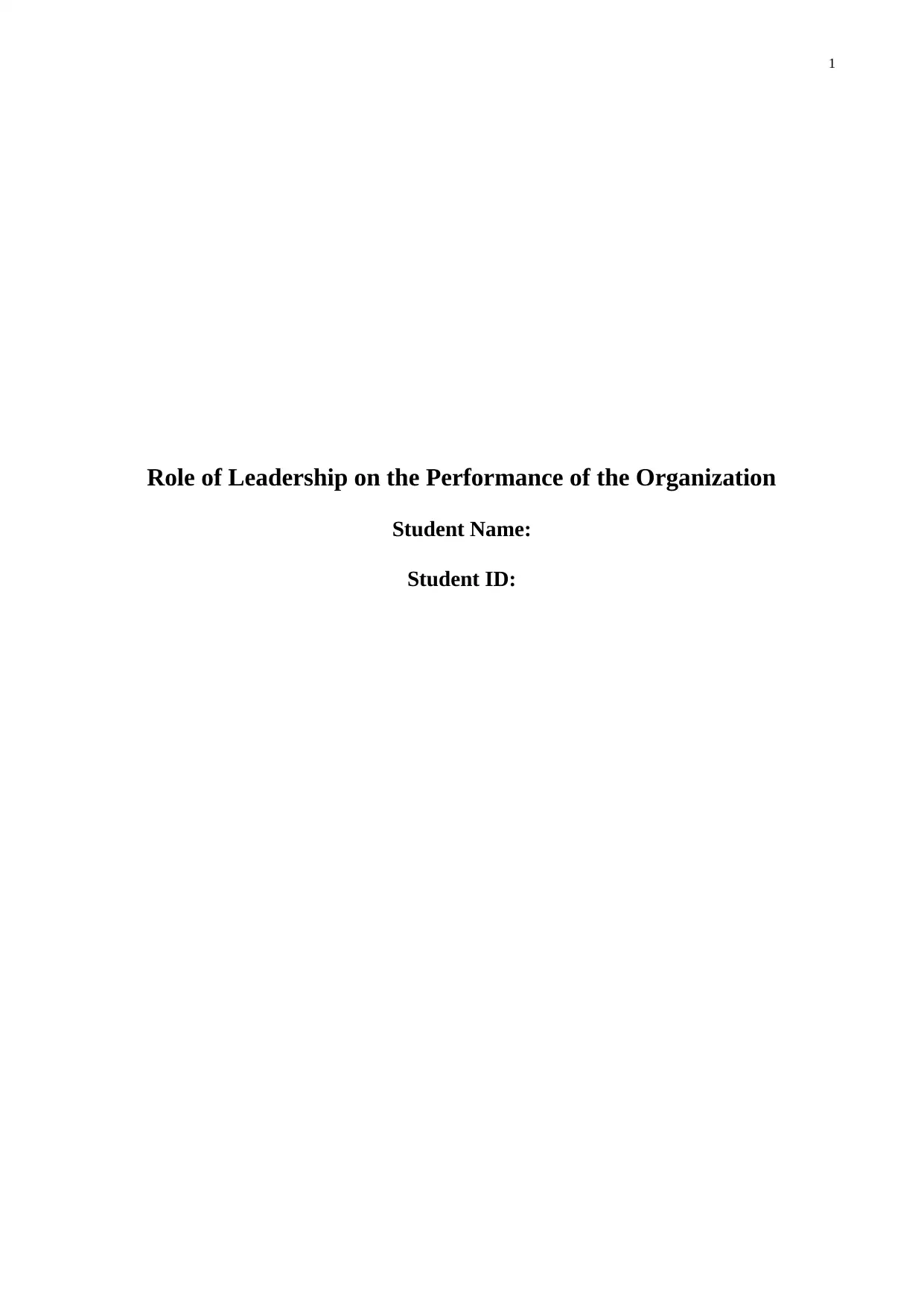
1
Role of Leadership on the Performance of the Organization
Student Name:
Student ID:
Role of Leadership on the Performance of the Organization
Student Name:
Student ID:
Paraphrase This Document
Need a fresh take? Get an instant paraphrase of this document with our AI Paraphraser
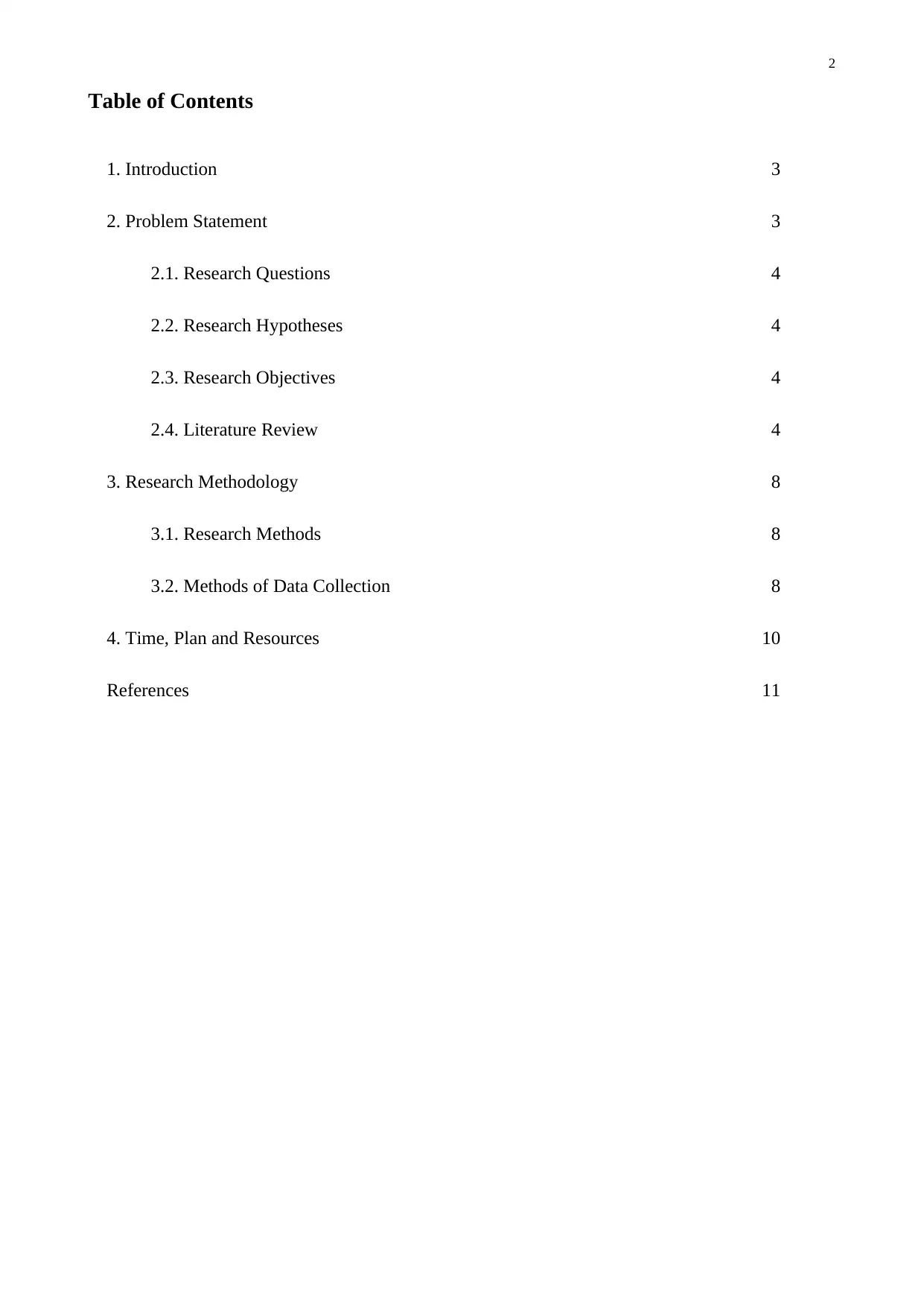
2
Table of Contents
1. Introduction 3
2. Problem Statement 3
2.1. Research Questions 4
2.2. Research Hypotheses 4
2.3. Research Objectives 4
2.4. Literature Review 4
3. Research Methodology 8
3.1. Research Methods 8
3.2. Methods of Data Collection 8
4. Time, Plan and Resources 10
References 11
Table of Contents
1. Introduction 3
2. Problem Statement 3
2.1. Research Questions 4
2.2. Research Hypotheses 4
2.3. Research Objectives 4
2.4. Literature Review 4
3. Research Methodology 8
3.1. Research Methods 8
3.2. Methods of Data Collection 8
4. Time, Plan and Resources 10
References 11

3
1. Introduction
Leadership is a process in which one person influences a group of people towards a strategic goal
and objective of an organization. The concept of leadership development has been utilized in
multiple areas ranging from politics, businesses, and academics. Various scholars have argued on
the impact and importance of leadership development in an organization, and the leadership traits
that are displayed by an individual are not just based on his personal skills. Still, it is significantly
shaped by the situation of the environment. Leadership development is present when an individual
decides to motivate a group of people so he can effectively modify their core competencies and
work towards achieving the overall objective of the organization (Southard, 2016).
Many businesses fail to implement an effective leadership style to monitor their management team,
which indicates that employees of the company are not efficient and thoroughly organized, and the
business is lagging behind due to its disrupted workforce. Leadership development is an essential
process for an organization as it increases the performance of the employees and results in enhanced
work productivity within the organization. Leadership development will increase the skills and
capabilities of the employees, for instance, building their motivation and communication skills (Al
Khajeh, 2018).
2. Problem Statement
It is becoming challenging for organizations to effectively manage their workforce and management
process. It is high time that managers identify the critical elements that are present within the
organization as they have an essential duty towards the organization. One of the critical roles of the
leader is to ensure that the employees are equally motivated and actively following the leadership
development process so it can enhance their skills and attributes. Previous literature states that
leadership behaviour has a high impact on organizational performance, although the findings of the
previous studies state mixed results regarding the impact of leadership behaviour on organizational
performance. Ascertain researches suggest that leadership has a critical role in the increased level of
organizational performance. In contrast, the other studies suggest that leadership does not play an
essential role in determining the increased level of performance of the organization. Therefore this
study will focus on understanding the role of leadership behaviors on organizational performance.
2.1. Research Questions
1. Introduction
Leadership is a process in which one person influences a group of people towards a strategic goal
and objective of an organization. The concept of leadership development has been utilized in
multiple areas ranging from politics, businesses, and academics. Various scholars have argued on
the impact and importance of leadership development in an organization, and the leadership traits
that are displayed by an individual are not just based on his personal skills. Still, it is significantly
shaped by the situation of the environment. Leadership development is present when an individual
decides to motivate a group of people so he can effectively modify their core competencies and
work towards achieving the overall objective of the organization (Southard, 2016).
Many businesses fail to implement an effective leadership style to monitor their management team,
which indicates that employees of the company are not efficient and thoroughly organized, and the
business is lagging behind due to its disrupted workforce. Leadership development is an essential
process for an organization as it increases the performance of the employees and results in enhanced
work productivity within the organization. Leadership development will increase the skills and
capabilities of the employees, for instance, building their motivation and communication skills (Al
Khajeh, 2018).
2. Problem Statement
It is becoming challenging for organizations to effectively manage their workforce and management
process. It is high time that managers identify the critical elements that are present within the
organization as they have an essential duty towards the organization. One of the critical roles of the
leader is to ensure that the employees are equally motivated and actively following the leadership
development process so it can enhance their skills and attributes. Previous literature states that
leadership behaviour has a high impact on organizational performance, although the findings of the
previous studies state mixed results regarding the impact of leadership behaviour on organizational
performance. Ascertain researches suggest that leadership has a critical role in the increased level of
organizational performance. In contrast, the other studies suggest that leadership does not play an
essential role in determining the increased level of performance of the organization. Therefore this
study will focus on understanding the role of leadership behaviors on organizational performance.
2.1. Research Questions
⊘ This is a preview!⊘
Do you want full access?
Subscribe today to unlock all pages.

Trusted by 1+ million students worldwide
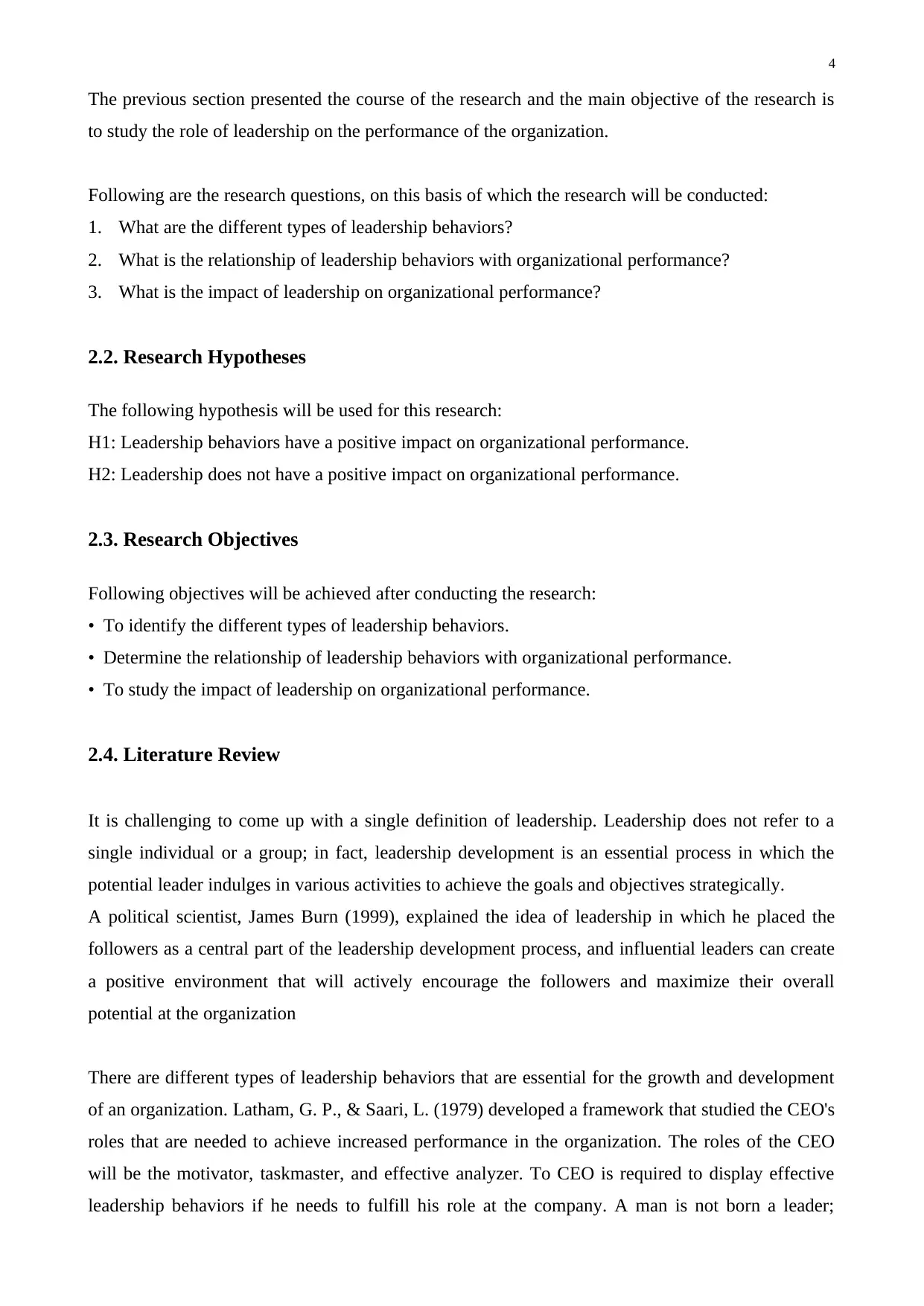
4
The previous section presented the course of the research and the main objective of the research is
to study the role of leadership on the performance of the organization.
Following are the research questions, on this basis of which the research will be conducted:
1. What are the different types of leadership behaviors?
2. What is the relationship of leadership behaviors with organizational performance?
3. What is the impact of leadership on organizational performance?
2.2. Research Hypotheses
The following hypothesis will be used for this research:
H1: Leadership behaviors have a positive impact on organizational performance.
H2: Leadership does not have a positive impact on organizational performance.
2.3. Research Objectives
Following objectives will be achieved after conducting the research:
• To identify the different types of leadership behaviors.
• Determine the relationship of leadership behaviors with organizational performance.
• To study the impact of leadership on organizational performance.
2.4. Literature Review
It is challenging to come up with a single definition of leadership. Leadership does not refer to a
single individual or a group; in fact, leadership development is an essential process in which the
potential leader indulges in various activities to achieve the goals and objectives strategically.
A political scientist, James Burn (1999), explained the idea of leadership in which he placed the
followers as a central part of the leadership development process, and influential leaders can create
a positive environment that will actively encourage the followers and maximize their overall
potential at the organization
There are different types of leadership behaviors that are essential for the growth and development
of an organization. Latham, G. P., & Saari, L. (1979) developed a framework that studied the CEO's
roles that are needed to achieve increased performance in the organization. The roles of the CEO
will be the motivator, taskmaster, and effective analyzer. To CEO is required to display effective
leadership behaviors if he needs to fulfill his role at the company. A man is not born a leader;
The previous section presented the course of the research and the main objective of the research is
to study the role of leadership on the performance of the organization.
Following are the research questions, on this basis of which the research will be conducted:
1. What are the different types of leadership behaviors?
2. What is the relationship of leadership behaviors with organizational performance?
3. What is the impact of leadership on organizational performance?
2.2. Research Hypotheses
The following hypothesis will be used for this research:
H1: Leadership behaviors have a positive impact on organizational performance.
H2: Leadership does not have a positive impact on organizational performance.
2.3. Research Objectives
Following objectives will be achieved after conducting the research:
• To identify the different types of leadership behaviors.
• Determine the relationship of leadership behaviors with organizational performance.
• To study the impact of leadership on organizational performance.
2.4. Literature Review
It is challenging to come up with a single definition of leadership. Leadership does not refer to a
single individual or a group; in fact, leadership development is an essential process in which the
potential leader indulges in various activities to achieve the goals and objectives strategically.
A political scientist, James Burn (1999), explained the idea of leadership in which he placed the
followers as a central part of the leadership development process, and influential leaders can create
a positive environment that will actively encourage the followers and maximize their overall
potential at the organization
There are different types of leadership behaviors that are essential for the growth and development
of an organization. Latham, G. P., & Saari, L. (1979) developed a framework that studied the CEO's
roles that are needed to achieve increased performance in the organization. The roles of the CEO
will be the motivator, taskmaster, and effective analyzer. To CEO is required to display effective
leadership behaviors if he needs to fulfill his role at the company. A man is not born a leader;
Paraphrase This Document
Need a fresh take? Get an instant paraphrase of this document with our AI Paraphraser
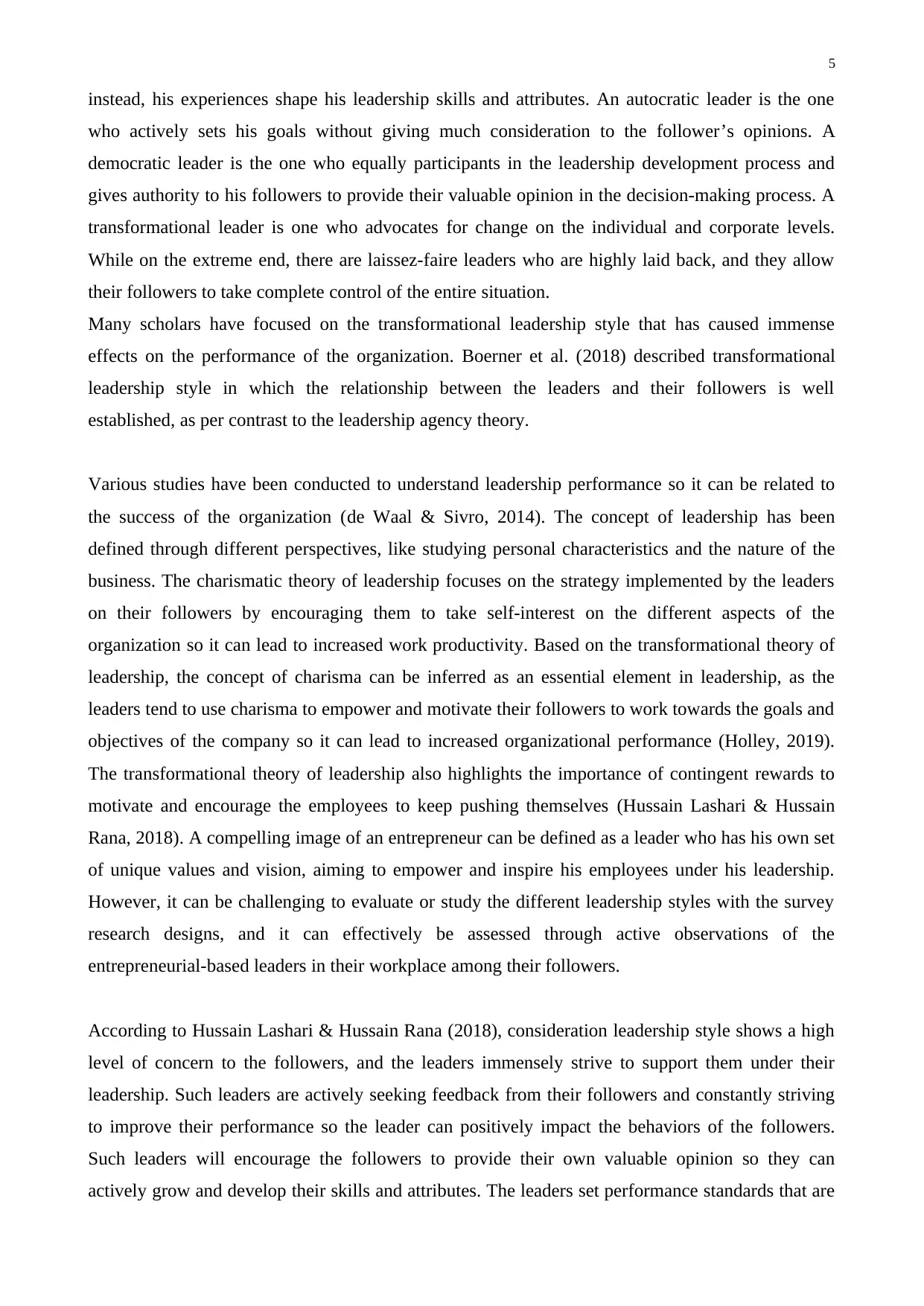
5
instead, his experiences shape his leadership skills and attributes. An autocratic leader is the one
who actively sets his goals without giving much consideration to the follower’s opinions. A
democratic leader is the one who equally participants in the leadership development process and
gives authority to his followers to provide their valuable opinion in the decision-making process. A
transformational leader is one who advocates for change on the individual and corporate levels.
While on the extreme end, there are laissez-faire leaders who are highly laid back, and they allow
their followers to take complete control of the entire situation.
Many scholars have focused on the transformational leadership style that has caused immense
effects on the performance of the organization. Boerner et al. (2018) described transformational
leadership style in which the relationship between the leaders and their followers is well
established, as per contrast to the leadership agency theory.
Various studies have been conducted to understand leadership performance so it can be related to
the success of the organization (de Waal & Sivro, 2014). The concept of leadership has been
defined through different perspectives, like studying personal characteristics and the nature of the
business. The charismatic theory of leadership focuses on the strategy implemented by the leaders
on their followers by encouraging them to take self-interest on the different aspects of the
organization so it can lead to increased work productivity. Based on the transformational theory of
leadership, the concept of charisma can be inferred as an essential element in leadership, as the
leaders tend to use charisma to empower and motivate their followers to work towards the goals and
objectives of the company so it can lead to increased organizational performance (Holley, 2019).
The transformational theory of leadership also highlights the importance of contingent rewards to
motivate and encourage the employees to keep pushing themselves (Hussain Lashari & Hussain
Rana, 2018). A compelling image of an entrepreneur can be defined as a leader who has his own set
of unique values and vision, aiming to empower and inspire his employees under his leadership.
However, it can be challenging to evaluate or study the different leadership styles with the survey
research designs, and it can effectively be assessed through active observations of the
entrepreneurial-based leaders in their workplace among their followers.
According to Hussain Lashari & Hussain Rana (2018), consideration leadership style shows a high
level of concern to the followers, and the leaders immensely strive to support them under their
leadership. Such leaders are actively seeking feedback from their followers and constantly striving
to improve their performance so the leader can positively impact the behaviors of the followers.
Such leaders will encourage the followers to provide their own valuable opinion so they can
actively grow and develop their skills and attributes. The leaders set performance standards that are
instead, his experiences shape his leadership skills and attributes. An autocratic leader is the one
who actively sets his goals without giving much consideration to the follower’s opinions. A
democratic leader is the one who equally participants in the leadership development process and
gives authority to his followers to provide their valuable opinion in the decision-making process. A
transformational leader is one who advocates for change on the individual and corporate levels.
While on the extreme end, there are laissez-faire leaders who are highly laid back, and they allow
their followers to take complete control of the entire situation.
Many scholars have focused on the transformational leadership style that has caused immense
effects on the performance of the organization. Boerner et al. (2018) described transformational
leadership style in which the relationship between the leaders and their followers is well
established, as per contrast to the leadership agency theory.
Various studies have been conducted to understand leadership performance so it can be related to
the success of the organization (de Waal & Sivro, 2014). The concept of leadership has been
defined through different perspectives, like studying personal characteristics and the nature of the
business. The charismatic theory of leadership focuses on the strategy implemented by the leaders
on their followers by encouraging them to take self-interest on the different aspects of the
organization so it can lead to increased work productivity. Based on the transformational theory of
leadership, the concept of charisma can be inferred as an essential element in leadership, as the
leaders tend to use charisma to empower and motivate their followers to work towards the goals and
objectives of the company so it can lead to increased organizational performance (Holley, 2019).
The transformational theory of leadership also highlights the importance of contingent rewards to
motivate and encourage the employees to keep pushing themselves (Hussain Lashari & Hussain
Rana, 2018). A compelling image of an entrepreneur can be defined as a leader who has his own set
of unique values and vision, aiming to empower and inspire his employees under his leadership.
However, it can be challenging to evaluate or study the different leadership styles with the survey
research designs, and it can effectively be assessed through active observations of the
entrepreneurial-based leaders in their workplace among their followers.
According to Hussain Lashari & Hussain Rana (2018), consideration leadership style shows a high
level of concern to the followers, and the leaders immensely strive to support them under their
leadership. Such leaders are actively seeking feedback from their followers and constantly striving
to improve their performance so the leader can positively impact the behaviors of the followers.
Such leaders will encourage the followers to provide their own valuable opinion so they can
actively grow and develop their skills and attributes. The leaders set performance standards that are
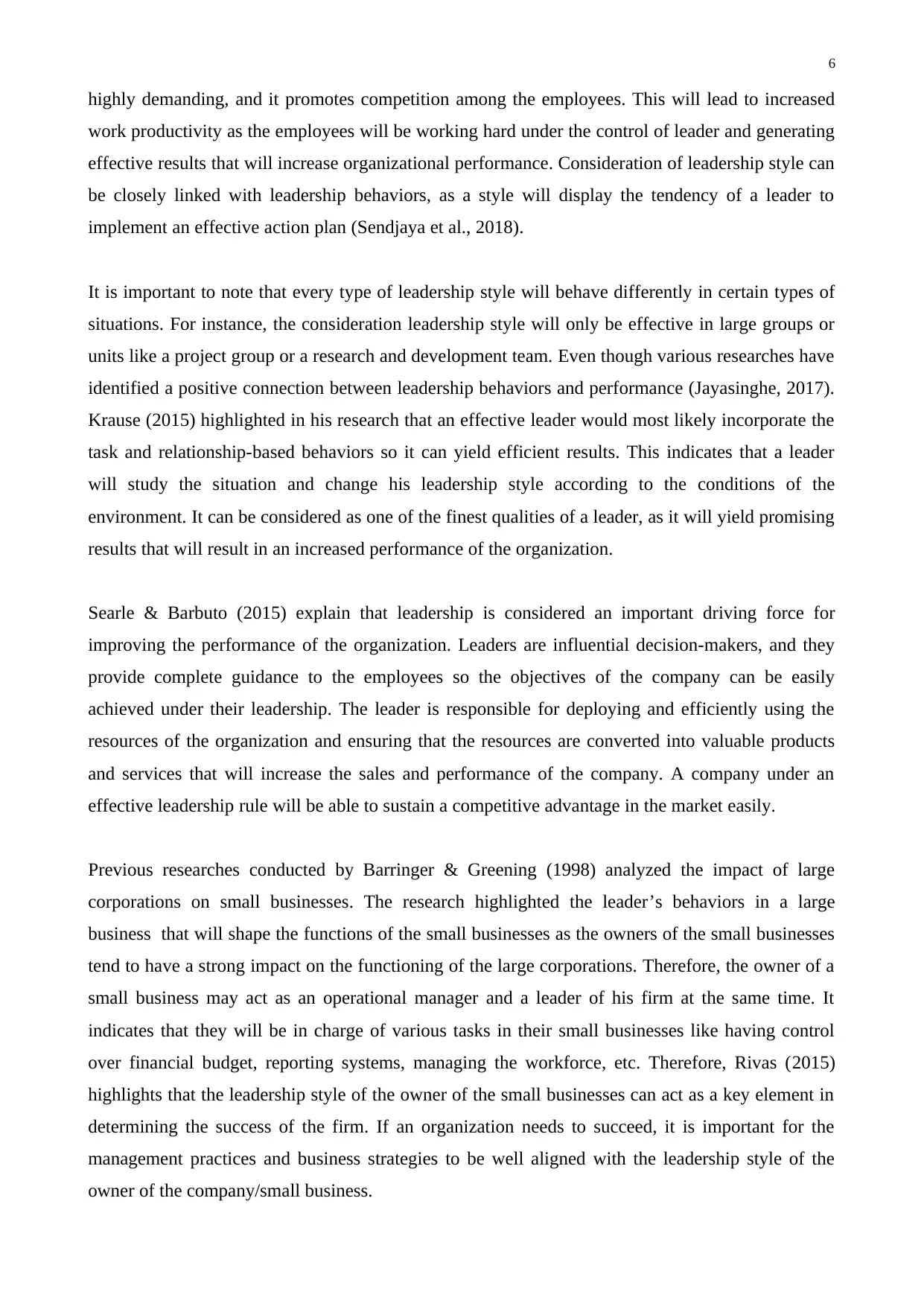
6
highly demanding, and it promotes competition among the employees. This will lead to increased
work productivity as the employees will be working hard under the control of leader and generating
effective results that will increase organizational performance. Consideration of leadership style can
be closely linked with leadership behaviors, as a style will display the tendency of a leader to
implement an effective action plan (Sendjaya et al., 2018).
It is important to note that every type of leadership style will behave differently in certain types of
situations. For instance, the consideration leadership style will only be effective in large groups or
units like a project group or a research and development team. Even though various researches have
identified a positive connection between leadership behaviors and performance (Jayasinghe, 2017).
Krause (2015) highlighted in his research that an effective leader would most likely incorporate the
task and relationship-based behaviors so it can yield efficient results. This indicates that a leader
will study the situation and change his leadership style according to the conditions of the
environment. It can be considered as one of the finest qualities of a leader, as it will yield promising
results that will result in an increased performance of the organization.
Searle & Barbuto (2015) explain that leadership is considered an important driving force for
improving the performance of the organization. Leaders are influential decision-makers, and they
provide complete guidance to the employees so the objectives of the company can be easily
achieved under their leadership. The leader is responsible for deploying and efficiently using the
resources of the organization and ensuring that the resources are converted into valuable products
and services that will increase the sales and performance of the company. A company under an
effective leadership rule will be able to sustain a competitive advantage in the market easily.
Previous researches conducted by Barringer & Greening (1998) analyzed the impact of large
corporations on small businesses. The research highlighted the leader’s behaviors in a large
business that will shape the functions of the small businesses as the owners of the small businesses
tend to have a strong impact on the functioning of the large corporations. Therefore, the owner of a
small business may act as an operational manager and a leader of his firm at the same time. It
indicates that they will be in charge of various tasks in their small businesses like having control
over financial budget, reporting systems, managing the workforce, etc. Therefore, Rivas (2015)
highlights that the leadership style of the owner of the small businesses can act as a key element in
determining the success of the firm. If an organization needs to succeed, it is important for the
management practices and business strategies to be well aligned with the leadership style of the
owner of the company/small business.
highly demanding, and it promotes competition among the employees. This will lead to increased
work productivity as the employees will be working hard under the control of leader and generating
effective results that will increase organizational performance. Consideration of leadership style can
be closely linked with leadership behaviors, as a style will display the tendency of a leader to
implement an effective action plan (Sendjaya et al., 2018).
It is important to note that every type of leadership style will behave differently in certain types of
situations. For instance, the consideration leadership style will only be effective in large groups or
units like a project group or a research and development team. Even though various researches have
identified a positive connection between leadership behaviors and performance (Jayasinghe, 2017).
Krause (2015) highlighted in his research that an effective leader would most likely incorporate the
task and relationship-based behaviors so it can yield efficient results. This indicates that a leader
will study the situation and change his leadership style according to the conditions of the
environment. It can be considered as one of the finest qualities of a leader, as it will yield promising
results that will result in an increased performance of the organization.
Searle & Barbuto (2015) explain that leadership is considered an important driving force for
improving the performance of the organization. Leaders are influential decision-makers, and they
provide complete guidance to the employees so the objectives of the company can be easily
achieved under their leadership. The leader is responsible for deploying and efficiently using the
resources of the organization and ensuring that the resources are converted into valuable products
and services that will increase the sales and performance of the company. A company under an
effective leadership rule will be able to sustain a competitive advantage in the market easily.
Previous researches conducted by Barringer & Greening (1998) analyzed the impact of large
corporations on small businesses. The research highlighted the leader’s behaviors in a large
business that will shape the functions of the small businesses as the owners of the small businesses
tend to have a strong impact on the functioning of the large corporations. Therefore, the owner of a
small business may act as an operational manager and a leader of his firm at the same time. It
indicates that they will be in charge of various tasks in their small businesses like having control
over financial budget, reporting systems, managing the workforce, etc. Therefore, Rivas (2015)
highlights that the leadership style of the owner of the small businesses can act as a key element in
determining the success of the firm. If an organization needs to succeed, it is important for the
management practices and business strategies to be well aligned with the leadership style of the
owner of the company/small business.
⊘ This is a preview!⊘
Do you want full access?
Subscribe today to unlock all pages.

Trusted by 1+ million students worldwide
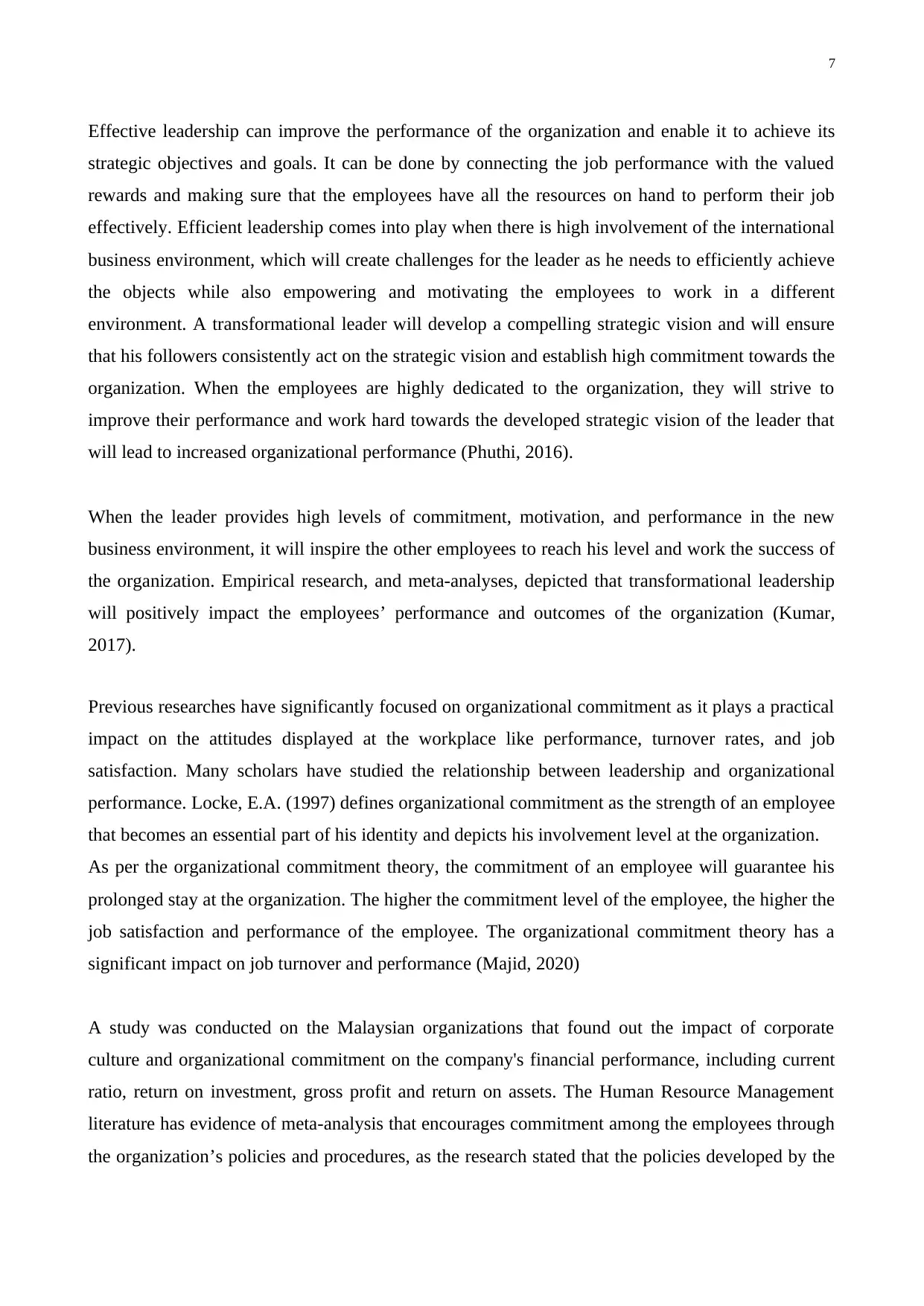
7
Effective leadership can improve the performance of the organization and enable it to achieve its
strategic objectives and goals. It can be done by connecting the job performance with the valued
rewards and making sure that the employees have all the resources on hand to perform their job
effectively. Efficient leadership comes into play when there is high involvement of the international
business environment, which will create challenges for the leader as he needs to efficiently achieve
the objects while also empowering and motivating the employees to work in a different
environment. A transformational leader will develop a compelling strategic vision and will ensure
that his followers consistently act on the strategic vision and establish high commitment towards the
organization. When the employees are highly dedicated to the organization, they will strive to
improve their performance and work hard towards the developed strategic vision of the leader that
will lead to increased organizational performance (Phuthi, 2016).
When the leader provides high levels of commitment, motivation, and performance in the new
business environment, it will inspire the other employees to reach his level and work the success of
the organization. Empirical research, and meta-analyses, depicted that transformational leadership
will positively impact the employees’ performance and outcomes of the organization (Kumar,
2017).
Previous researches have significantly focused on organizational commitment as it plays a practical
impact on the attitudes displayed at the workplace like performance, turnover rates, and job
satisfaction. Many scholars have studied the relationship between leadership and organizational
performance. Locke, E.A. (1997) defines organizational commitment as the strength of an employee
that becomes an essential part of his identity and depicts his involvement level at the organization.
As per the organizational commitment theory, the commitment of an employee will guarantee his
prolonged stay at the organization. The higher the commitment level of the employee, the higher the
job satisfaction and performance of the employee. The organizational commitment theory has a
significant impact on job turnover and performance (Majid, 2020)
A study was conducted on the Malaysian organizations that found out the impact of corporate
culture and organizational commitment on the company's financial performance, including current
ratio, return on investment, gross profit and return on assets. The Human Resource Management
literature has evidence of meta-analysis that encourages commitment among the employees through
the organization’s policies and procedures, as the research stated that the policies developed by the
Effective leadership can improve the performance of the organization and enable it to achieve its
strategic objectives and goals. It can be done by connecting the job performance with the valued
rewards and making sure that the employees have all the resources on hand to perform their job
effectively. Efficient leadership comes into play when there is high involvement of the international
business environment, which will create challenges for the leader as he needs to efficiently achieve
the objects while also empowering and motivating the employees to work in a different
environment. A transformational leader will develop a compelling strategic vision and will ensure
that his followers consistently act on the strategic vision and establish high commitment towards the
organization. When the employees are highly dedicated to the organization, they will strive to
improve their performance and work hard towards the developed strategic vision of the leader that
will lead to increased organizational performance (Phuthi, 2016).
When the leader provides high levels of commitment, motivation, and performance in the new
business environment, it will inspire the other employees to reach his level and work the success of
the organization. Empirical research, and meta-analyses, depicted that transformational leadership
will positively impact the employees’ performance and outcomes of the organization (Kumar,
2017).
Previous researches have significantly focused on organizational commitment as it plays a practical
impact on the attitudes displayed at the workplace like performance, turnover rates, and job
satisfaction. Many scholars have studied the relationship between leadership and organizational
performance. Locke, E.A. (1997) defines organizational commitment as the strength of an employee
that becomes an essential part of his identity and depicts his involvement level at the organization.
As per the organizational commitment theory, the commitment of an employee will guarantee his
prolonged stay at the organization. The higher the commitment level of the employee, the higher the
job satisfaction and performance of the employee. The organizational commitment theory has a
significant impact on job turnover and performance (Majid, 2020)
A study was conducted on the Malaysian organizations that found out the impact of corporate
culture and organizational commitment on the company's financial performance, including current
ratio, return on investment, gross profit and return on assets. The Human Resource Management
literature has evidence of meta-analysis that encourages commitment among the employees through
the organization’s policies and procedures, as the research stated that the policies developed by the
Paraphrase This Document
Need a fresh take? Get an instant paraphrase of this document with our AI Paraphraser
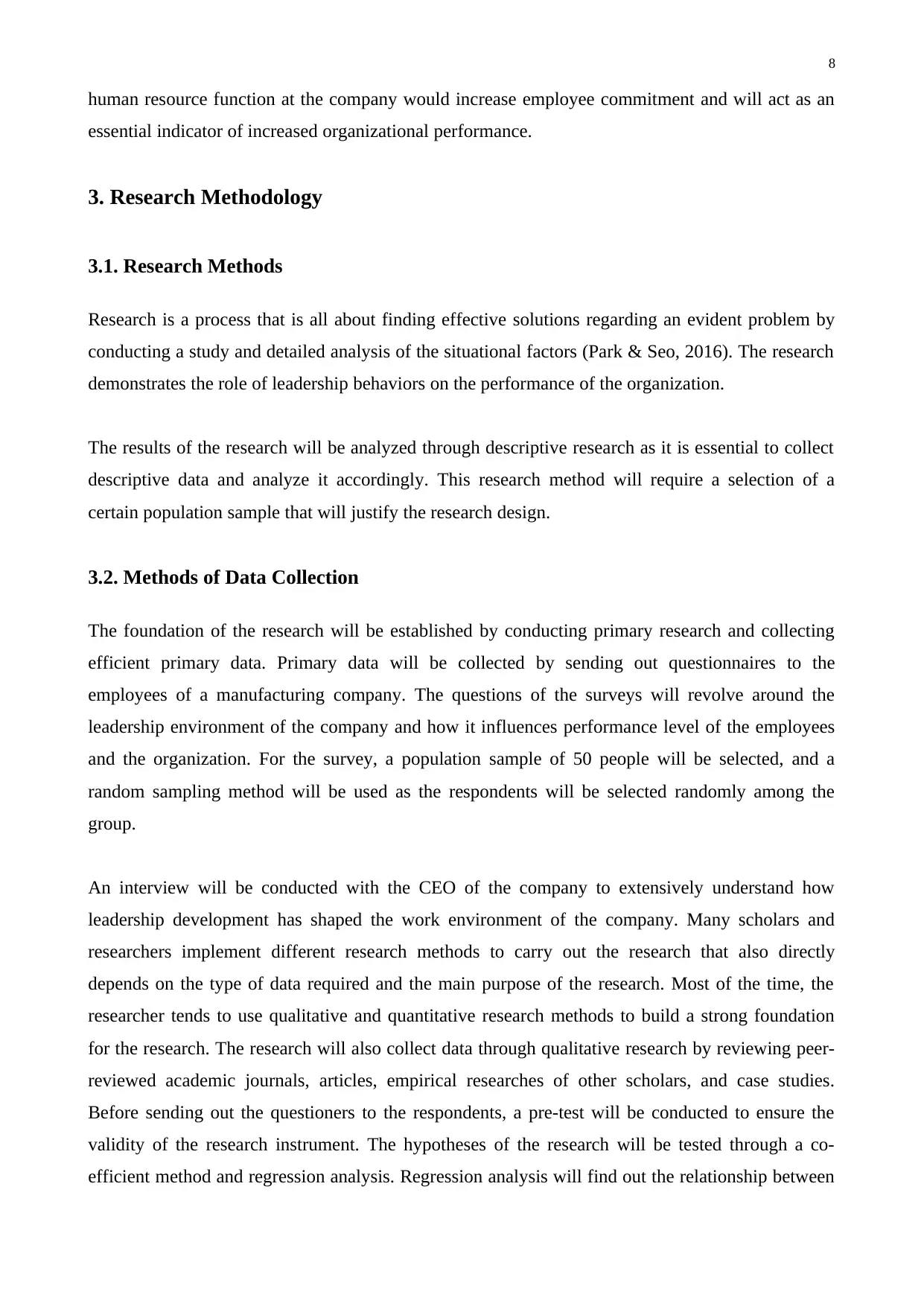
8
human resource function at the company would increase employee commitment and will act as an
essential indicator of increased organizational performance.
3. Research Methodology
3.1. Research Methods
Research is a process that is all about finding effective solutions regarding an evident problem by
conducting a study and detailed analysis of the situational factors (Park & Seo, 2016). The research
demonstrates the role of leadership behaviors on the performance of the organization.
The results of the research will be analyzed through descriptive research as it is essential to collect
descriptive data and analyze it accordingly. This research method will require a selection of a
certain population sample that will justify the research design.
3.2. Methods of Data Collection
The foundation of the research will be established by conducting primary research and collecting
efficient primary data. Primary data will be collected by sending out questionnaires to the
employees of a manufacturing company. The questions of the surveys will revolve around the
leadership environment of the company and how it influences performance level of the employees
and the organization. For the survey, a population sample of 50 people will be selected, and a
random sampling method will be used as the respondents will be selected randomly among the
group.
An interview will be conducted with the CEO of the company to extensively understand how
leadership development has shaped the work environment of the company. Many scholars and
researchers implement different research methods to carry out the research that also directly
depends on the type of data required and the main purpose of the research. Most of the time, the
researcher tends to use qualitative and quantitative research methods to build a strong foundation
for the research. The research will also collect data through qualitative research by reviewing peer-
reviewed academic journals, articles, empirical researches of other scholars, and case studies.
Before sending out the questioners to the respondents, a pre-test will be conducted to ensure the
validity of the research instrument. The hypotheses of the research will be tested through a co-
efficient method and regression analysis. Regression analysis will find out the relationship between
human resource function at the company would increase employee commitment and will act as an
essential indicator of increased organizational performance.
3. Research Methodology
3.1. Research Methods
Research is a process that is all about finding effective solutions regarding an evident problem by
conducting a study and detailed analysis of the situational factors (Park & Seo, 2016). The research
demonstrates the role of leadership behaviors on the performance of the organization.
The results of the research will be analyzed through descriptive research as it is essential to collect
descriptive data and analyze it accordingly. This research method will require a selection of a
certain population sample that will justify the research design.
3.2. Methods of Data Collection
The foundation of the research will be established by conducting primary research and collecting
efficient primary data. Primary data will be collected by sending out questionnaires to the
employees of a manufacturing company. The questions of the surveys will revolve around the
leadership environment of the company and how it influences performance level of the employees
and the organization. For the survey, a population sample of 50 people will be selected, and a
random sampling method will be used as the respondents will be selected randomly among the
group.
An interview will be conducted with the CEO of the company to extensively understand how
leadership development has shaped the work environment of the company. Many scholars and
researchers implement different research methods to carry out the research that also directly
depends on the type of data required and the main purpose of the research. Most of the time, the
researcher tends to use qualitative and quantitative research methods to build a strong foundation
for the research. The research will also collect data through qualitative research by reviewing peer-
reviewed academic journals, articles, empirical researches of other scholars, and case studies.
Before sending out the questioners to the respondents, a pre-test will be conducted to ensure the
validity of the research instrument. The hypotheses of the research will be tested through a co-
efficient method and regression analysis. Regression analysis will find out the relationship between
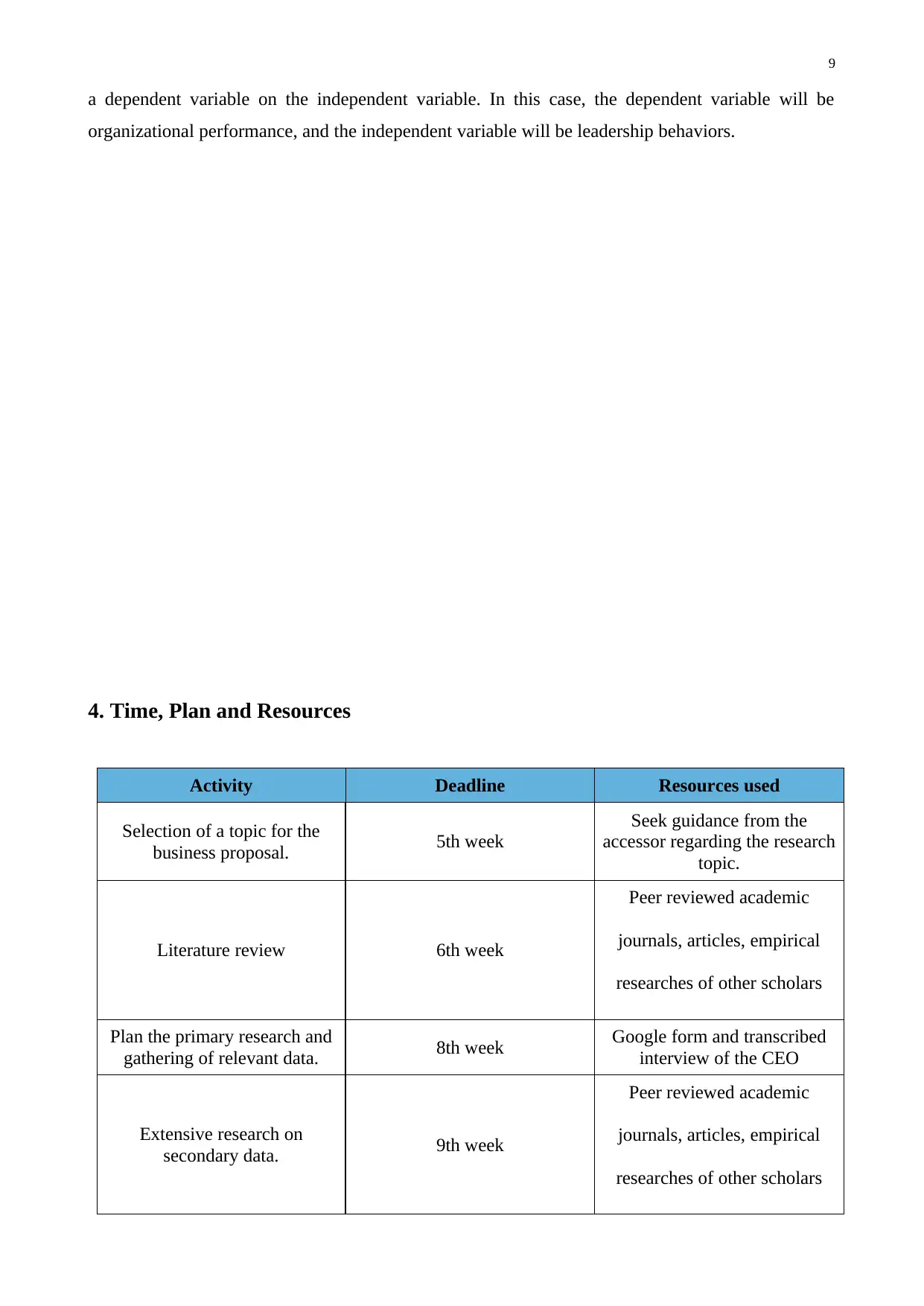
9
a dependent variable on the independent variable. In this case, the dependent variable will be
organizational performance, and the independent variable will be leadership behaviors.
4. Time, Plan and Resources
Activity Deadline Resources used
Selection of a topic for the
business proposal. 5th week
Seek guidance from the
accessor regarding the research
topic.
Literature review 6th week
Peer reviewed academic
journals, articles, empirical
researches of other scholars
Plan the primary research and
gathering of relevant data. 8th week Google form and transcribed
interview of the CEO
Extensive research on
secondary data. 9th week
Peer reviewed academic
journals, articles, empirical
researches of other scholars
a dependent variable on the independent variable. In this case, the dependent variable will be
organizational performance, and the independent variable will be leadership behaviors.
4. Time, Plan and Resources
Activity Deadline Resources used
Selection of a topic for the
business proposal. 5th week
Seek guidance from the
accessor regarding the research
topic.
Literature review 6th week
Peer reviewed academic
journals, articles, empirical
researches of other scholars
Plan the primary research and
gathering of relevant data. 8th week Google form and transcribed
interview of the CEO
Extensive research on
secondary data. 9th week
Peer reviewed academic
journals, articles, empirical
researches of other scholars
⊘ This is a preview!⊘
Do you want full access?
Subscribe today to unlock all pages.

Trusted by 1+ million students worldwide

10
Activity Deadline Resources used
Effective integration of the
researched data. 11th week Data will be presented through
graphs, bars, charts and tables.
Conduct analysis of the
primary data and record the
results.
12th week SPSS and Microsoft Excel.
Compilation of the final
research report. 14th week Microsoft Word
Submission of the research
report. 15th week University’s Portal.
References
Al Khajeh, E. (2018). Impact of Leadership Styles on Organizational Performance. Journal Of
Human Resources Management Research, 3(6), 1-10.
Barringer, B. R., & Greening, D. W. (1998). Small business growth through geographic expansion:
A comparative case study Journal of Business Venturing, 13, 467-492.
Boerner, S., Eisenbeiss, S., & Griesser, D. (2018). Follower Behavior and Organizational
Performance: The Impact of Transformational Leaders. Journal Of Leadership & Organizational
Studies, 13(3), 15-26.
Activity Deadline Resources used
Effective integration of the
researched data. 11th week Data will be presented through
graphs, bars, charts and tables.
Conduct analysis of the
primary data and record the
results.
12th week SPSS and Microsoft Excel.
Compilation of the final
research report. 14th week Microsoft Word
Submission of the research
report. 15th week University’s Portal.
References
Al Khajeh, E. (2018). Impact of Leadership Styles on Organizational Performance. Journal Of
Human Resources Management Research, 3(6), 1-10.
Barringer, B. R., & Greening, D. W. (1998). Small business growth through geographic expansion:
A comparative case study Journal of Business Venturing, 13, 467-492.
Boerner, S., Eisenbeiss, S., & Griesser, D. (2018). Follower Behavior and Organizational
Performance: The Impact of Transformational Leaders. Journal Of Leadership & Organizational
Studies, 13(3), 15-26.
Paraphrase This Document
Need a fresh take? Get an instant paraphrase of this document with our AI Paraphraser
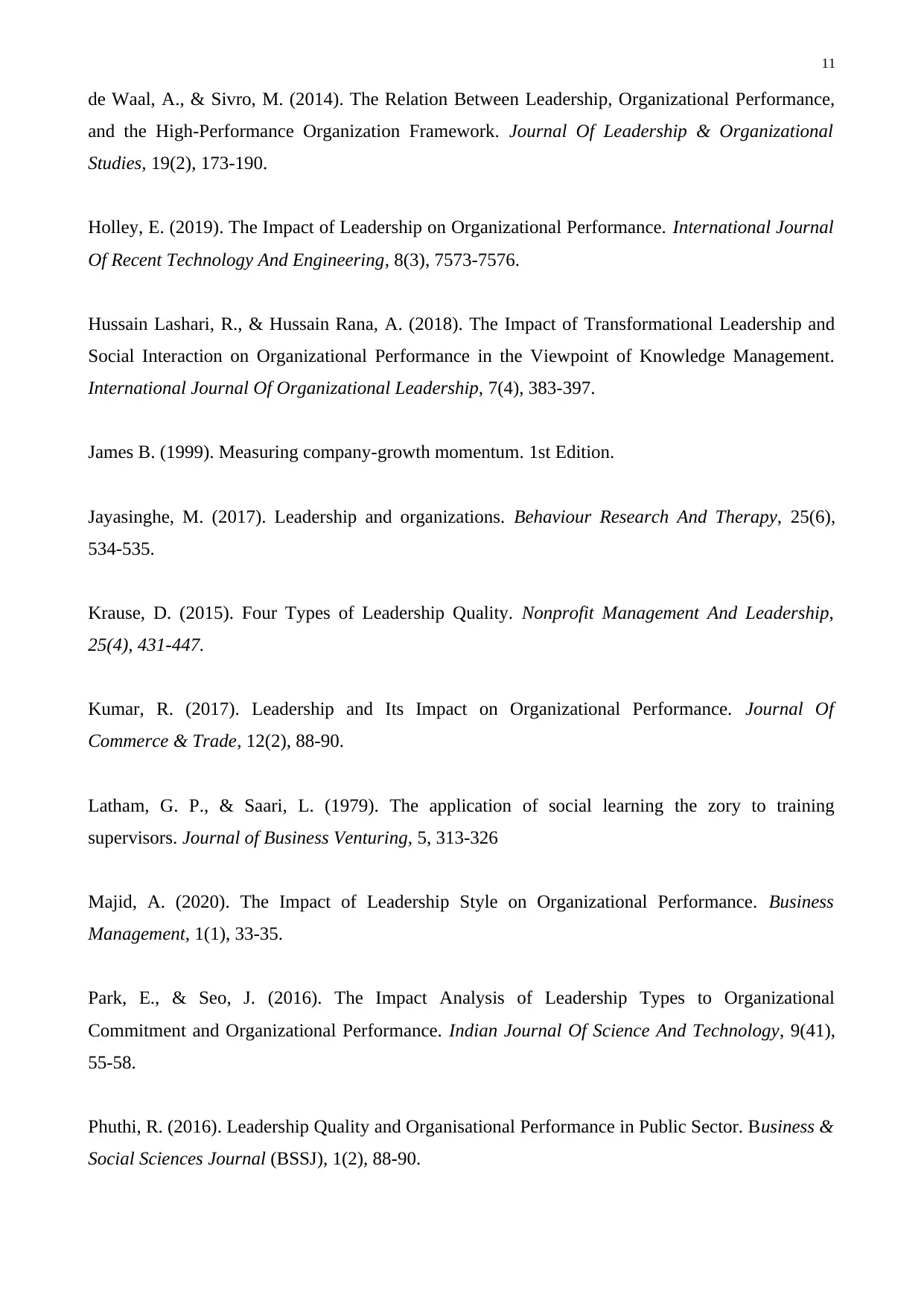
11
de Waal, A., & Sivro, M. (2014). The Relation Between Leadership, Organizational Performance,
and the High-Performance Organization Framework. Journal Of Leadership & Organizational
Studies, 19(2), 173-190.
Holley, E. (2019). The Impact of Leadership on Organizational Performance. International Journal
Of Recent Technology And Engineering, 8(3), 7573-7576.
Hussain Lashari, R., & Hussain Rana, A. (2018). The Impact of Transformational Leadership and
Social Interaction on Organizational Performance in the Viewpoint of Knowledge Management.
International Journal Of Organizational Leadership, 7(4), 383-397.
James B. (1999). Measuring company-growth momentum. 1st Edition.
Jayasinghe, M. (2017). Leadership and organizations. Behaviour Research And Therapy, 25(6),
534-535.
Krause, D. (2015). Four Types of Leadership Quality. Nonprofit Management And Leadership,
25(4), 431-447.
Kumar, R. (2017). Leadership and Its Impact on Organizational Performance. Journal Of
Commerce & Trade, 12(2), 88-90.
Latham, G. P., & Saari, L. (1979). The application of social learning the zory to training
supervisors. Journal of Business Venturing, 5, 313-326
Majid, A. (2020). The Impact of Leadership Style on Organizational Performance. Business
Management, 1(1), 33-35.
Park, E., & Seo, J. (2016). The Impact Analysis of Leadership Types to Organizational
Commitment and Organizational Performance. Indian Journal Of Science And Technology, 9(41),
55-58.
Phuthi, R. (2016). Leadership Quality and Organisational Performance in Public Sector. Business &
Social Sciences Journal (BSSJ), 1(2), 88-90.
de Waal, A., & Sivro, M. (2014). The Relation Between Leadership, Organizational Performance,
and the High-Performance Organization Framework. Journal Of Leadership & Organizational
Studies, 19(2), 173-190.
Holley, E. (2019). The Impact of Leadership on Organizational Performance. International Journal
Of Recent Technology And Engineering, 8(3), 7573-7576.
Hussain Lashari, R., & Hussain Rana, A. (2018). The Impact of Transformational Leadership and
Social Interaction on Organizational Performance in the Viewpoint of Knowledge Management.
International Journal Of Organizational Leadership, 7(4), 383-397.
James B. (1999). Measuring company-growth momentum. 1st Edition.
Jayasinghe, M. (2017). Leadership and organizations. Behaviour Research And Therapy, 25(6),
534-535.
Krause, D. (2015). Four Types of Leadership Quality. Nonprofit Management And Leadership,
25(4), 431-447.
Kumar, R. (2017). Leadership and Its Impact on Organizational Performance. Journal Of
Commerce & Trade, 12(2), 88-90.
Latham, G. P., & Saari, L. (1979). The application of social learning the zory to training
supervisors. Journal of Business Venturing, 5, 313-326
Majid, A. (2020). The Impact of Leadership Style on Organizational Performance. Business
Management, 1(1), 33-35.
Park, E., & Seo, J. (2016). The Impact Analysis of Leadership Types to Organizational
Commitment and Organizational Performance. Indian Journal Of Science And Technology, 9(41),
55-58.
Phuthi, R. (2016). Leadership Quality and Organisational Performance in Public Sector. Business &
Social Sciences Journal (BSSJ), 1(2), 88-90.

12
Rivas, R. (2015). Dysfunctional Leadership and its Impact on Organizational Performance.
International Management Journal, 3(5), 66-72.
Searle, T., & Barbuto, J. (2015). Servant Leadership, Hope, and Organizational Virtuousness: A
Framework Exploring Positive Micro and Macro Behaviors and Performance Impact. Journal Of
Leadership & Organizational Studies, 18(1), 107-117.
Sendjaya, S., Sarros, J., & Santora, J. (2018). Defining and Measuring Servant Leadership
Behaviour in Organizations. Journal Of Management Studies, 45(2), 402-424.
Southard, M. (2016). Implementing Challenging Policy and Systems Change: Identifying
Leadership Competencies. Human Service Organizations: Management, Leadership &
Governance, 1(5), 35-44.
Rivas, R. (2015). Dysfunctional Leadership and its Impact on Organizational Performance.
International Management Journal, 3(5), 66-72.
Searle, T., & Barbuto, J. (2015). Servant Leadership, Hope, and Organizational Virtuousness: A
Framework Exploring Positive Micro and Macro Behaviors and Performance Impact. Journal Of
Leadership & Organizational Studies, 18(1), 107-117.
Sendjaya, S., Sarros, J., & Santora, J. (2018). Defining and Measuring Servant Leadership
Behaviour in Organizations. Journal Of Management Studies, 45(2), 402-424.
Southard, M. (2016). Implementing Challenging Policy and Systems Change: Identifying
Leadership Competencies. Human Service Organizations: Management, Leadership &
Governance, 1(5), 35-44.
⊘ This is a preview!⊘
Do you want full access?
Subscribe today to unlock all pages.

Trusted by 1+ million students worldwide
1 out of 12
Related Documents
Your All-in-One AI-Powered Toolkit for Academic Success.
+13062052269
info@desklib.com
Available 24*7 on WhatsApp / Email
![[object Object]](/_next/static/media/star-bottom.7253800d.svg)
Unlock your academic potential
Copyright © 2020–2025 A2Z Services. All Rights Reserved. Developed and managed by ZUCOL.





